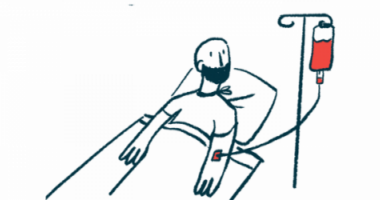Switching to next-gen ERT can help stabilize motor function in LOPD
No significant differences in lung function after 1 year: Small study in France

Switching to Nexviadyme (avalglucosidase alfa) from Myozyme (alglucosidase alfa) can help to halt the worsening of motor function in adults with late-onset Pompe disease (LOPD), according to a recent study in France.
However, no significant differences in lung function were reported after patients switched these enzyme replacement therapies (ERT).
“These data provide important information on the impact of this new ERT in real life for patients suffering from advanced LOPD and declining despite alglucosidase alfa [Myozyme] therapy,” researchers wrote.
The study, “Real-life effectiveness 1 year after switching to avalglucosidase alfa in late-onset Pompe disease patients worsening on alglucosidase alfa therapy: A French cohort study,” was published in the European Journal of Neurology.
Pompe disease is caused by mutations in the GAA gene, resulting in a lack or deficiency of acid alpha-glucosidase (GAA). This enzyme is required to break down a complex sugar called glycogen into glucose, which the body uses to obtain energy, particularly muscle cells.
LOPD symptoms typically start after 1 year of age
In LOPD, symptoms typically start after 1 year of age until adulthood. The disease is characterized by symptoms such as muscle weakness and breathing problems.
ERT, which provides a functional version of the GAA enzyme, is a standard Pompe disease treatment. It includes Sanofi’s Myozyme and the more recent Nexviadyme, which are sold in the U.S. as Lumizyme and Nexviazyme, respectively.
Nexviadyme is a next-generation ERT developed to be more efficient than Myozyme in delivering the enzyme to muscle cells. It is approved in the U.S. for LOPD patients, 1 and older, while in Europe it is approved for both infantile-onset Pompe and late-onset disease.
In France, results from the Phase 3 COMET trial (NCT02782741) showed better lung and motor function with Nexviadyme than with Myozyme, which had led many patients to switch therapies even before Nexviadyme was formally approved. This switch was made by patients not responding to Myozyme, such as those with significant worsening of respiratory and/or motor function after at least one year into Myozyme treatment, without some other disease or bone fracture that could account for the clinical deterioration.
In the new study, researchers in France set out to provide real-life data on adults with LOPD who failed to respond to Myozyme and switched to Nexviadyme. For that, they analyzed a total of 29 patients followed in the French Pompe registry, which is partly sponsored by Sanofi.
At the time of the switch, the patients were a mean age of 56.2 years, and had been treated with Myozyme for a mean of 10.9 years.
Lung, motor function remained stable 1 year after switching treatments
Before the switch, patients had a mean forced vital capacity (FVC) — a measure of respiratory function based on how much air a person can forcibly exhale in a breath — of 1,993 mL, which remained stable one year after the switch. This corresponded to a median percent predicted FVC of 49.5%.
Motor function, as assessed by the six-minute walk test that measures the distance a patient can walk in six minutes, also remained stable.
When accounting for individual variations, the findings showed significant stabilization of motor function worsening after patients switched to Nexviadyme, corresponding to a 2.5% improvement in the year after the switch, compared with a 33% worsening in the year before.
Corresponding changes in respiratory parameters were not statistically different. Seven patients with more severely affected respiratory function, according to their FVC, at the time of the switch were considered good responders one year later, while five patients were deemed bad responders as they showed further worsening.
Future studies should assess this switch in more patients over a longer period, and report data from other countries, the scientists noted.
“Although the limited number of patients due to the rarity of this disease and the 1-year duration of treatment prevent robust statistical analyses, we thought it important to report these data in order to aid decision-making for future therapies,” the researchers concluded.








